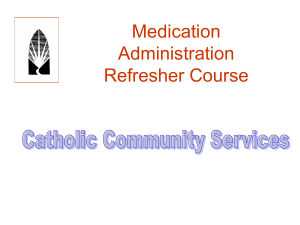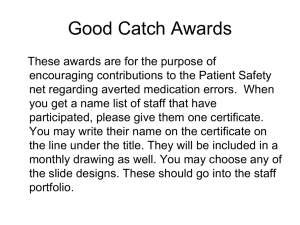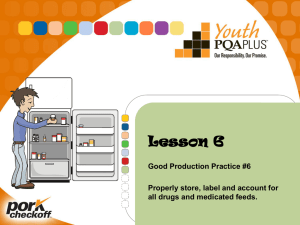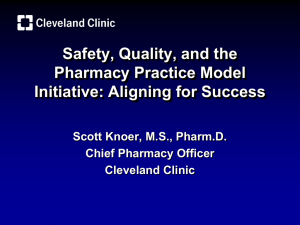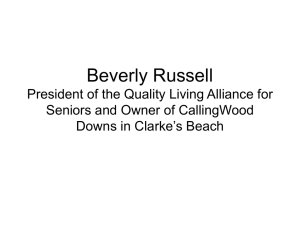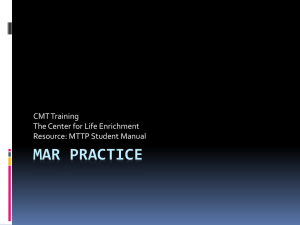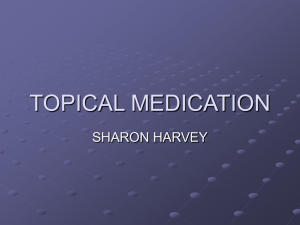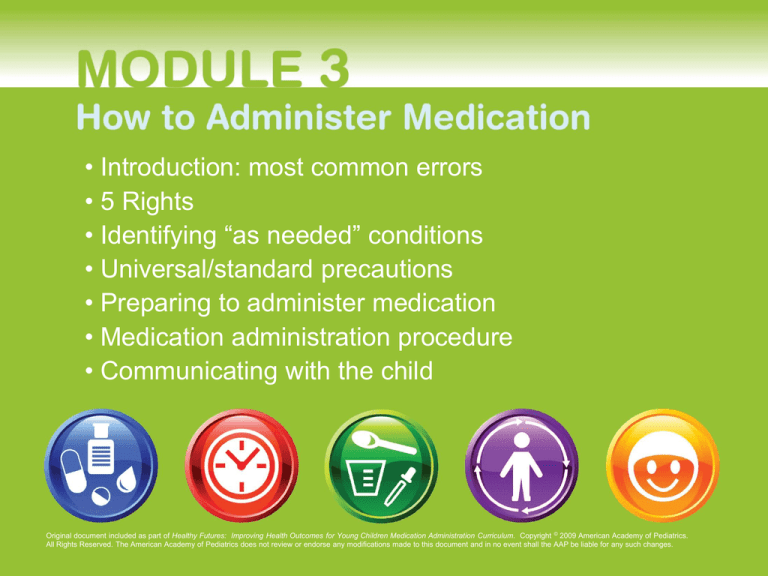
• Introduction: most common errors
• 5 Rights
• Identifying “as needed” conditions
• Universal/standard precautions
• Preparing to administer medication
• Medication administration procedure
• Communicating with the child
Original document included as part of Healthy Futures: Improving Health Outcomes for Young Children Medication Administration Curriculum. Copyright © 2009 American Academy of Pediatrics.
All Rights Reserved. The American Academy of Pediatrics does not review or endorse any modifications made to this document and in no event shall the AAP be liable for any such changes.
Medication Administration Curriculum - Module 3
Introduction: Common Errors
in Medication Administration
7,000 children per year require emergency
department visits for medication problems
• Common errors
–
–
–
–
Took medication twice
Wrong medication
Incorrect dose
Missed dose
• Common causes
– Not understanding medication label
– Not understanding how to give medication
– Poor communication between parents/guardians and health care
professional
Medication Administration Curriculum - Module 3
Most Common Medication Errors
• Errors are most commonly made with analgesics,
which is the class of medication which includes
Tylenol® (acetaminophen) and Motrin® (ibuprofen)
• Reasons for errors include:
– These medications are given frequently
– There are many different concentrations (infant drops,
children’s liquids, etc)
– They are often mixed with other medications in cough and
cold preparations
– Dosing charts are unique to the type and form of the
medication
Medication Administration Curriculum - Module 3
The “5 Rights”
•
•
•
•
•
Right child
Right medication
Right dose
Right time
Right route
Medication Administration Curriculum - Module 3
Right Child
• Check the name on the medication label and the
child’s name
• If any question arises, check a second identifier such
as date of birth
Medication Administration Curriculum - Module 3
Right Medication
• Read the label to make sure you have the correct
medication
• Check to see:
– Medication is in the original labeled container
– Expiration date is not exceeded
• Especially important for children who are taking more
than 1 medication
Medication Administration Curriculum - Module 3
Right Dose
• Check dose on label and authorization form
• Use proper measuring device
• Check measuring device carefully
Medication Administration Curriculum - Module 3
Right Time
• Check the permission form to match the time with
the label
• Check that medication is being given within 30
minutes before or after prescribed time
• Look at the clock and note the time
• The right time includes both time and date
• In an emergency, “now” is the right time to give
medication
Medication Administration Curriculum - Module 3
Right Route
• Check the label and Authorization to Give Medicine
form
• How is the medication to be given?
Medication Administration Curriculum - Module 3
“As Needed” Conditions
• Some medication, such as emergency medication, only
need to be given “as needed”
• Health care professionals and other prescribers should not
write “as needed” or “prn” without more specific instructions
– Example of acceptable, specific instructions: albuterol – 2 puffs as
needed for wheezing, increased cough, or breathing difficulty
• OTC medication for pain and fever should be kept to a
minimum and should be as specific as possible
• The order should state the maximum number of times the
dose can be repeated before seeking further medical care
Medication Administration Curriculum - Module 3
Standard Precautions in Child Care Settings
Standard Precautions
• The term for the infection control measures that all
heath and child care providers should follow in order to
protect themselves from infectious diseases and to
prevent the spread of infectious diseases to those in
their care
• Sometimes called universal precautions
Medication Administration Curriculum - Module 3
Standard Precautions in Child Care Settings
What Do They Consist Of?
• Handwashing
– Handwashing with soap and water should be done before medication
administration
– An individual towel should be available for each handwashing
– Hand sanitizers (alcohol based rubs) should be limited to times when
soap and water are not available
– Hand sanitizers should be kept out of reach of children and their use
should be supervised
• Disposable gloves
• Proper disposal of materials
• Environmental sanitation
Medication Administration Curriculum - Module 3
Group Activity:
Prepare to Administer Medication to Nick
• List the steps to prepare to give medication to Nick
Medication Administration Curriculum - Module 3
Group Activity: Prepare to Administer
Medication to Nick, continued
Steps
• Wash hands
• Prepare work area
• Take out the medication
• Check the label and the items on the forms to see that
they match
• Get proper measuring device
• Check the time
Medication Administration Curriculum - Module 3
Medication Administration Procedure:
Prepare the Medication
• Find appropriate measuring device
• Measure the amount on the label
• Change the form of the medication ONLY if label
states for you to do so:
– Crushed or powdered medication
– Sprinkles
– Mix with food
Medication Administration Curriculum - Module 3
Medication and Food
• It is usually best not to mix medication with food, but it
may be necessary
• Ask the prescriber or pharmacist before mixing
medication with food or liquid
• If medication is mixed with food or liquid, ALL of it
must be taken
• Give the child something to drink immediately
afterward to help with the taste
Medication Administration Curriculum - Module 3
Medication Administration Procedure:
Prepare the Child
• Communicate with the child
• Explain the procedure to the child
– Never call medication “candy”
• Wash the child’s hands, if appropriate
• Position the child
Medication Administration Curriculum - Module 3
Prepare the Child: Infants
• Support the infant’s head
• Hold the baby semi-upright
– An infant seat may be used
•
•
•
•
Keep the infant’s arms and hands away from her face
Gently press the chin to open the mouth
Rock the baby before and after
Syringe or dropper:
– Position on one side of the mouth along the gum
– Squirt slowly to allow time to swallow
• Special dosing nipples work best when the baby is hungry
• Give oral medication before feeding unless instructed otherwise
Medication Administration Curriculum - Module 3
Prepare the Child: Toddlers
• Ask parents what techniques they use
• Give toddlers some control, like sitting or standing, but
do not give veto power over taking the medication
• Be honest about bad taste and allow the child to drink
afterwards
• Use age-appropriate language to explain what you are
doing
• Maintain an attitude that you expect cooperation
• Thank the child for their cooperation and praise them
Medication Administration Curriculum - Module 3
Prepare the Child: Older Children
• Explain why we take medication and why they help us
to get better
• Use the opportunity to teach about time, body parts,
health, and illness
• Involving the child in the process helps to prepare him
to take his own medication as he gets older
• Books that talk about medication are helpful to read
with the child
Medication Administration Curriculum - Module 3
Medication Administration Procedure
• Check 5 rights: child, medication, dose, time, and
route
– Note any special instructions
• Take the medication from the container
– Prepare the medication
• Check the label again
• Give the medication
– Never give more or less, accuracy is very important
Medication Administration Curriculum - Module 3
Medication Administration Procedure:
Finishing Up
• Praise the child
• Check the label again
• Return the medication to storage immediately
– Never leave medication unattended
• Record the medication, date, time, dose, route, and
your signature on the Medication Log
• Clean the measuring device
• Wash your hands
• Observe the child for side effects
Medication Administration Curriculum - Module 3
After Giving Medication
• Allow the child the opportunity to express his or her
feelings
• Acknowledge that some medication is difficult to take
• Encourage the child that next time will be easier
• Offer to spend time with the child
Medication Administration Curriculum - Module 3
Oral Medication Video:
How to Give Oral Medication
Click button to play video
Medication Administration Curriculum - Module 3
Measuring Oral Medication
• Oral Measuring Devices
– Dropper
– Syringes: ½ tsp or less is most accurately measured with
syringe or similar device
– Dosing spoon
– Medication cup
• No kitchen teaspoons!
Medication Administration Curriculum - Module 3
Topical Medication Video:
How to Give Topical Medication
Click button to play video
Medication Administration Curriculum - Module 3
Topical Medication Video:
How to Give Eye Drops
Click button to play video
Medication Administration Curriculum - Module 3
Topical Medication Video:
How to Give Ear Drops
Click button to play video
Medication Administration Curriculum - Module 3
Topical Medication
• Skin creams, ointments, patches
• Eye drops, ointments
• Ear drops
Medication Administration Curriculum - Module 3
Inhaled Medication
• Nasal sprays and drops
• Metered dose inhalers and nebulizers


